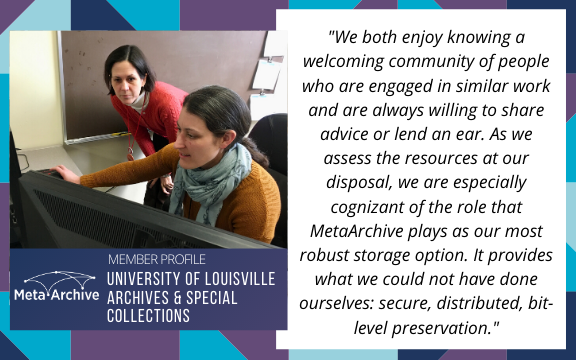MetaArchive Member Profile: University of Louisville Archives & Special Collections
March 25, 2020
By: Kyna Herzinger, Archivist for Record Management, and Rachel Howard, Digital Initiatives Librarian

Tell us a bit about the digital preservation program at your organization?
Our colleague, Rare Books Curator Delinda Buie, happened to be in the right place at the right time when Martin Halbert and others discussed applying for an NDIIPP (National Digital Information Infrastructure and Preservation Program) grant to explore distributed digital preservation at an ARL (Association of Research Libraries) meeting in 2003. At the time, UofL did not have a formal digitization program, but the Special Collections department, in which Delinda worked, had been doing ad hoc digitization for customer orders and exhibits for several years. The successful NDIIPP grant evolved into the MetaArchive Cooperative, and locally led to the creation of the Digital Initiatives program, in which Rachel Howard has served since 2006 and has overseen Digital Collections of cultural heritage materials and an institutional repository of university scholarship. UofL’s digital preservation efforts focused on digitized images and oral histories. In 2017, after Kyna Herzinger had joined the team, UofL took steps to develop a framework for a digital preservation program, drafting policies, exploring tools, and documenting workflows. At that time, UofL’s digital preservation expanded to include born-digital university records, oral histories, and community collections.
Looking ahead, what are you excited about, or what’s on the horizon for your program?
In terms of content, we are looking forward to preserving our electronic theses and dissertations, which are currently backed up in the cloud. We plan to establish a workflow to have them harvested into the MetaArchive network. In terms of maturing our overall program, we have identified two areas of focus. Having no single position that is responsible for handling born-digital content, we are still ensuring that our curators can accession and process their own born-digital collections. This means fine-tuning workflows. We are also starting to shift focus toward improving access to born-digital content, both in terms of discovery and researcher support.

In photo, L-R: Rachel Howard, Kyna Herzinger
Tell us a bit about your local workflow. How has the MetaArchive preservation storage service been incorporated?
For digitized content, after creating master and access files and metadata and launching a digital collection to the public, Rachel would copy master files and an XML file of the metadata to a staging server and organize them into archival units (AUs) of acceptable size for ingest into the MetaArchive network. The size of those AUs grew over time as we tested network capabilities, so that, for example, our yearbooks, whose master files ballooned to as much as 50 GB per yearbook, could each be treated as a single AU, thus requiring less “data wrangling”. She would then create a manifest page and (as was required in the early days) plugin, document the locations of those files and the AUs in the MetaArchive Conspectus database, and then work with MetaArchive partners to test and then ingest the collection into the preservation storage network.
Now, with born-digital content, we use the BagIt profile specification, and recently participated in the MetaArchive’s SuperNode Pilot project, testing Bagit + OwnCloud and Exactly + SFTP to ingest content into the network.
Tell us about your experience in participating in the MetaArchive community. How has it influenced you or your work?
We both enjoy knowing a welcoming community of people who are engaged in similar work and are always willing to share advice or lend an ear. Working together with this group has also provided us with opportunities for research and professional leadership/ service at an international level. As we assess the resources at our disposal, we are especially cognizant of the role that the MetaArchive plays as our most robust storage option. It provides what we could not have done ourselves: secure, distributed, bit-level preservation.
Tell us a bit about your experience participating in the Changing for Continued Impact Series? What have been some of your key takeaways from the series thus far?
It has been reenergizing to connect in a more focused way with the partners as we talk about the past, present, and future of the Cooperative. The series has provided reassurance that growing pains are normal, that challenges are opportunities for growth, and that it is better to be proactive about change than to wait until circumstances demand an immediate reaction.We appreciate being part of a community in which we have a say in its future.
Editorial note: “Since late 2019 the MetaArchive community has been undergoing a series of intensive evaluations of both their organizational model as well as their technical approaches to distributed digital preservation (DDP). This is the Changing for Continued Impact (CFCI) Series, a facilitated framework led by Educopia that engages the MetaArchive members in a series of focused-discussions and work-sessions. This generative and co-creative process got underway in earnest this past Fall 2019, and will continue through Spring 2020 leading up to the next Annual MetaArchive Membership Meeting.”